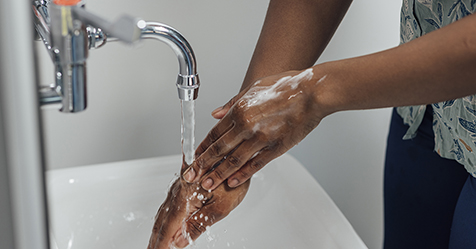A dingy, worn-out, and stained floor can impact how people view a facility. Therefore, it’s important to make floors clean, shiny, and bright to present a good impression. A good floor finish can do just that.
In this article, you’ll discover important details on taking care of the finish of your building’s floors, not only for a better appearance, but also for better protection—in terms of the physical floors as well as for the pedestrians who use them.
Be sure to also check out the Straight Talk! video and podcast at the end of this article to learn even more from Becky Kaufold, the manager of government affairs and sustainability at Spartan Chemical Company, and the chair of the floor care products division with the Household & Commercial Products Association (HCPA).
The primary purpose of floor finish is to provide protection to both the substrate and the pedestrian. Maintaining a wear layer on the substrate protects the flooring from deep scratches, soil entrapment, and staining caused by traffic and the environment. The wear layer also seals the floor with specific ingredients that increase the coefficient of friction, which in turn helps prevent pedestrian slips.
Floor finish: General care
To ensure the finish maintains a safe coefficient of friction, proper preventative and routine maintenance regimes are essential. Preventative maintenance includes the placement of walk-off mats and wet floor signs (in cases of precipitation, spills, or wet cleaning), as well as regular dust mopping. Proper routine maintenance includes regular wet cleaning or damp mopping. Utilizing a well-built cleaner to mop or autoscrub the floor will help suspend and remove soils and contaminants that could cause slips and falls.
Floor finish: Winter care
During the winter months, building residents and visitors commonly track rock salt residue into facilities. The salt granules can cause scratches and deep gouges in a floor. Saltwater or powdered salt residue can leave high-gloss floors looking dull and dingy.
To avoid damaged floors, begin by preventing and/or removing as much salt as possible outside the building before it can be tracked onto the inside floors. This can be done by increasing the number or length of walk-off mats, using scrape-type mats, and increasing vacuuming or dust-mopping frequency.
If salt is tracked onto a floor, remove any large salt particulates and wet mop the remaining soil load. It is important to note that salt is an inorganic molecule and, as such, it is neither an acid nor a base. Thus, it is chemically impossible to “neutralize” salt. Instead, cleaning salt residue is a function of solubilizing an abnormally heavy soil load and properly suspending it, so the soil does not redeposit.
Resilient floor neutralizers, which are designed for use after floor strippers, are often considered the best “salt neutralizer.” Unlike conventional pH-neutral cleaners, which are designed to clean normal soil loads at low-use levels, resilient floor neutralizers are used at more concentrated dilutions. Due to the dilution rate of the floor neutralizer, there is a higher level of surfactant to solubilize and suspend the residue. Consequentially, the increased detergency and solubility of the floor-neutralizing solution, rather than the pH of the solution, determines salt removal.
To maintain the integrity of a floor finish, a pH-neutral cleaner is optimal for daily floor maintenance. That being said, when a building is experiencing heavy soil load, such as increased salt residue during the winter, an adjustment in damp-mop frequency and/or a slight increase of the pH-neutral cleaner will provide an efficient method to manage momentary periods of heavy soil.
Alternatively, utilizing an autoscrubber helps maintain a floor’s high gloss finish while preventing potential damage during the maintenance procedure. For best results, damp mop enough cleaning solution to dissolve the salt. Once the floor is sufficiently wet, remove the slurry solution on the floor with a wet/dry vacuum or an autoscrubber set to vacuum only. After the floor is clear of salt residue, proceed with the normal autoscrub or cleaning procedure.
Using the proper chemistry and procedure will allow you to maintain safe and clean floors, even during the most aggressive winter months.
To learn more on creating and maintaining a great finish on your building’s floors, watch the video or listen to the podcast of the Straight Talk! episode below.


